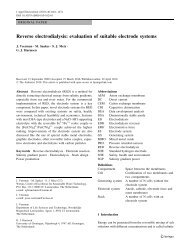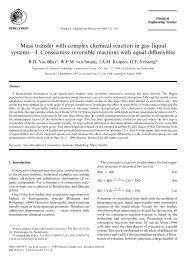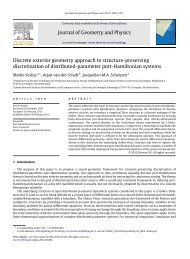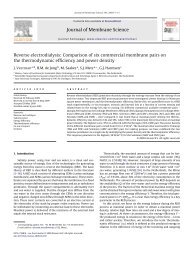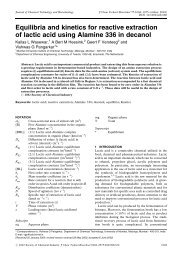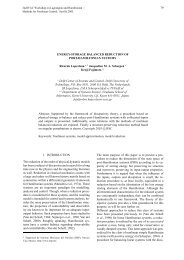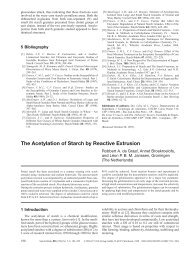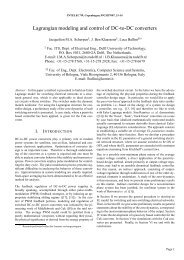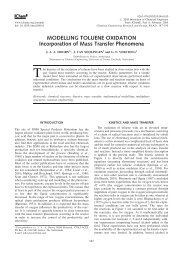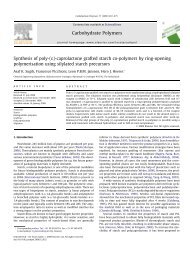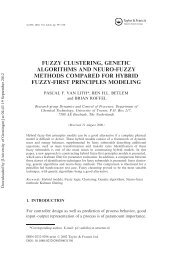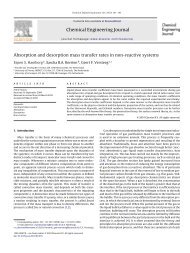Lyapunov-Based Control Scheme for Single-Phase Grid ... - ITM
Lyapunov-Based Control Scheme for Single-Phase Grid ... - ITM
Lyapunov-Based Control Scheme for Single-Phase Grid ... - ITM
Create successful ePaper yourself
Turn your PDF publications into a flip-book with our unique Google optimized e-Paper software.
528 IEEE TRANSACTIONS ON CONTROL SYSTEMS TECHNOLOGY, VOL. 20, NO. 2, MARCH 2012characteristics, one corresponding to an irradiance of1000 Wm and another corresponding to an irradianceof 500 Wm . The experimental test consisted in thesudden change of the 1000 Wm electrical characteristicsset to the 500 Wm and then restoring the 1000Wm electrical characteristics set after a given time.This operation is shown in Fig. 11. This test is equivalentto an improvable worst case scenario and there<strong>for</strong>e itis a good way to validate the robustness of the designedcontroller.The values of the tunable parameters of the controller, i.e.,gains and , have been defined mainly to avoid numericalproblems (e.g., saturation of the signals, quantization problems).There<strong>for</strong>e the gain has been chosen as large as possible butavoiding saturation of signal . The adaptive gain has beenchosen such that a smooth non-oscillating dynamics is obtained.The final values of gains used were and.Figs. 12 and 13 show the results of the a<strong>for</strong>ementioned experimentaltests. In the case of Experimental Test 1 (see Fig. 12) itcan be seen that the output current is always in phase with thegrid voltage and that the capacitor voltage eventually reachesits desired steady-state value. The controller parameters havebeen intentionally set such that a smooth closed-loop voltagedynamics is obtained in order to avoid the introduction of unwantedharmonics in the output current, i.e., in single-phase PVpower inverters the effects of the voltage dynamics directly affectsthe output current.Fig. 13 shows the electrical behavior of the full-bridge inverterprototype with the designed control scheme <strong>for</strong> ExperimentalTest 2. Notice that when the abrupt step-down irradiancechange occurs ( 2.8 s), after a settling time approximatelyequal to 0.3 s, the system is able to reach the desired steady state.A similar settling time is obtained when the step-up irradiancechange occurs ( 7.05 s). Note that during the complete experimentaltest the current injected to the utility grid is always inphase with the grid voltage. It should be remarked that the differencein the response of during the step-down and step-upirradiance change is due to the nonlinear behavior of the system.The nonlinear behavior becomes more apparent in the presenceof large set-point changes, disturbances, or errors that cause thesystem to deviate from its nominal point of operation.VI. CONCLUSIONA novel approach to the controller design <strong>for</strong> single-phasesingle-stage grid-connected power inverters is presented. Insteadof linearizing the system, the control design approachaims to derive a global asymptotically stable closed-loopsystem that takes into account the nonlinear time-varying characteristicsof the system. The robustness of the controller hasbeen improved by adding an adaptive control law. A further theoreticalanalysis of the closed-loop system supported by meansof numerical simulations allows to simplify the implementationof the controller. A laboratory prototype was built in order totest the closed-loop per<strong>for</strong>mance of the controlled system. Theexperimental test per<strong>for</strong>med consisted of an abrupt change ofthe PV array irradiance. Even though such sudden and largechange is not likely to occur in reality, it serves to underscorethe robustness and effectiveness of the proposed controller. Theexperimental results showed that the implemented controllerwas able to meet the desired control requirements, i.e., toextract a given amount of power from the PV array (solar arraysimulator, in the case of the experimental prototype) and toinject to the utility grid a current in phase with the grid voltageeven under extreme changes in the system parameters.The results of this paper should be considered as a proofof principle. It is expected that the proposed controller providesa similar per<strong>for</strong>mance as those obtained using standardlinear controller design techniques. Moreover, the inclusion ofthe nonlinear characteristics guarantees the closed-loop systemto operate robustly and reliable, even in the presence of largeset-point changes, disturbances, or errors that cause the systemto deviate from its nominal point of operation. It is our believethat further research in the design and analysis of PV power systemsconsidering and respecting their nonlinear nature may helpto obtain more efficient and reliable management and control algorithmsthan the ones currently available.REFERENCES[1] G. Petrone, G. Spagnuolo, R. Teodorescu, M. Veerachary, and M.Vitelli, “Reliability issues in photovoltaic power processing systems,”IEEE Trans. Ind. Electron., vol. 55, no. 7, pp. 2569–2580, Jul. 2008.[2] D. Zmood and D. Holmes, “Stationary frame current regulation ofPWM inverters with zero steady-state error,” IEEE Trans. PowerElectron., vol. 18, no. 3, pp. 814–822, May 2003.[3] R. Teodorescu, F. Blaabjerg, M. Liserre, and P. C. Loh, “Proportionalresonantcontrollers and filters <strong>for</strong> grid-connected voltage-source converters,”IEE Trans. Power Appl., vol. 153, no. 5, pp. 750–762, Sep.2006, 2006.[4] F. Blaabjerg, R. Teodorescu, M. Liserre, and A. V. Timubs, “Overviewof control and grid synchronization <strong>for</strong> distributed power generationsystems,” IEEE Trans. Ind. Electron., vol. 53, no. 5, pp. 1398–1409,Oct. 2006.[5] M. Ciobotaru, R. Teodorescu, and F. Blaabjerg, “<strong>Control</strong> of singlestagesingle-phase pv inverter,” in Proc. Eur. Conf. Power Electron.Appl., 2005, pp. 1–10.[6] C. Hua, J. Lin, and C. Shen, “Implementation of a dsp-controlled photovoltaicsystem with peak power tracking,” IEEE Trans. Ind. Electron.,vol. 45, no. 1, pp. 99–107, Feb. 1998.[7] M. Veerachary, T. Senjyu, and K. Uezato, “Voltage-based maximumpower point tracking control of PV system,” IEEE Trans. Aerosp. Electron.Syst., vol. 38, no. 1, pp. 262–270, Jan. 2002.[8] N. Femia, G. Petrone, G. Spagnuolo, and M. Vitelli, “Optimization ofperturb and observe maximum power point tracking method,” IEEETrans. Power Electron., vol. 20, no. 4, pp. 963–973, Jul. 2005.[9] R. Teodorescu, F. Blaabjerg, U. Borup, and M. Liserre, “A new controlstructure <strong>for</strong> grid-connected LCL PV inverters with zero steadystateerror and selective harmonic compensation,” in Proc. Appl. PowerElectron. Conf. Expo., 2004, pp. 580–586.[10] C.-Y. Chan, “A nonlinear control <strong>for</strong> DC-DC power converters,” IEEETrans. Power Electron., vol. 22, no. 1, pp. 216–222, Jan. 2007.[11] M. M. J. de Vries, M. J. Kransse, M. Liserre, V. G. Monopoli, and J. M.A. Scherpen, “Passivity-based harmonic control through series/paralleldamping of an h-bridge rectifier,” in Proc. Int. Symp. Ind. Electron.,2007, pp. 3385–3390.[12] D. Jeltsema and J. M. A. Scherpen, “A power-based perspective inmodeling and control of switched power converters [past and present],”IEEE Ind. Electron. Mag., vol. 1, no. 1, pp. 7–54, May 2007.[13] A. Gensior, H. Sira-Ramirez, J. Rudolph, and H. Guldner, “On somenonlinear current controllers <strong>for</strong> three-phase boost rectifiers,” IEEETrans. Ind. Electron., vol. 56, no. 2, pp. 360–370, Feb. 2009.[14] S. Sanders and G. Verghese, “<strong>Lyapunov</strong>-based control <strong>for</strong> switchedpower converters,” IEEE Trans. Power Electron., vol. 7, no. 1, pp.17–24, Jan. 1992.



